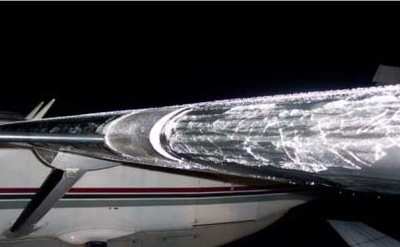Fri, Dec 08, 2006
Aero-Tips!
A good pilot is always learning -- how many times have you heard
this old standard throughout your flying career? There is no truer
statement in all of flying (well, with the possible exception of
"there are no old, bold pilots.")

Aero-News has called upon the expertise of Thomas P. Turner,
master CFI and all-around-good-guy, to bring our readers -- and us
-- daily tips to improve our skills as aviators. Some of them, you
may have heard before... but for each of us, there will also be
something we might never have considered before, or something that
didn't "stick" the way it should have the first time we memorized
it for the practical test.
Look for our daily Aero-Tips segments, coming each day to you
through the Aero-News Network.
Aero-Tips 12.08.06
Most pilots are used to the Pilot Report (PIREP) intensity
reports for structural ice accumulation. Describing ice as "light,
moderate or severe" gives a good idea of whether a pilot may or
should venture into those conditions. But sometimes pilots want a
little more information about the ice's characteristics --
especially if flying an aircraft that can safely (and legally) plan
a flight into "known ice."

The Aeronautical Information Manual (AIM)
contains a table that gives standardizes descriptors for an
"amplified" icing PIREP. Consider how hearing each type of report,
alone or in combination, would affect your decision making before
takeoff, and if you first heard the report while aloft.
-
Clear Ice --
See Glaze Ice.
-
Glaze Ice --
Ice, sometimes clear and smooth, but usually containing some air
pockets, which results in a lumpy translucent appearance. Glaze ice
results from supercooled drops/droplets striking a surface but not
freezing rapidly on contact. Glaze ice is denser, harder, and
sometimes more transparent than rime ice. Factors, which favor
glaze formation, are those that favor slow dissipation of the heat
of fusion (i.e., slight supercooling and rapid accretion). With
larger accretions, the ice shape typically includes "horns"
protruding from unprotected leading edge surfaces. It is the ice
shape, rather than the clarity or color of the ice, which is most
likely to be accurately assessed from the cockpit. The terms
"clear" and "glaze" have been used for essentially the same type of
ice accretion, although some reserve "clear" for thinner accretions
which lack horns and conform to the airfoil.
-
Intercycle
Ice -- Ice which accumulates on a protected surface
between actuation cycles of a deicing system.
-
Known or Observed or
Detected Ice Accretion -- Actual ice observed visually
to be on the aircraft by the flight crew or identified by on-board
sensors.
-
Mixed Ice --
Simultaneous appearance or a combination of rime and glaze ice
characteristics. Since the clarity, color, and shape of the ice
will be a mixture of rime and glaze characteristics, accurate
identification of mixed ice from the cockpit may be
difficult.
-
Residual Ice
-- Ice which remains on a protected surface immediately after the
actuation of a deicing system.
-
Rime Ice --
A rough, milky, opaque ice formed by the rapid freezing of
supercooled drops/droplets after they strike the aircraft. The
rapid freezing results in air being trapped, giving the ice its
opaque appearance and making it porous and brittle. Rime ice
typically accretes along the stagnation line of an airfoil and is
more regular in shape and conformal to the airfoil than glaze ice.
It is the ice shape, rather than the clarity or color of the ice,
which is most likely to be accurately assessed from the
cockpit.
-
Runback Ice
-- Ice which forms from the freezing or refreezing of water leaving
protected surfaces and running back to unprotected surfaces.
Aero-tip of the day: Using the proper
terminology helps you better understand icing PIREPs, and for your
reports to have more meaning for other pilots.
More News
Runway Centerline Lighting Flush centerline lights spaced at 50-foot intervals beginning 75 feet from the landing threshold and extending to within 75 feet of the opposite end of t>[...]
Aero Linx: Air Force Global Strike Command Air Force Global Strike Command, activated August 7, 2009, is a major command with headquarters at Barksdale Air Force Base, Louisiana, i>[...]
Also: Viasat-uAvionix, UL94 Fuel Investigation, AF Materiel Command, NTSB Safety Alert Norges Luftsportforbund chose Aura Aero's little 2-seater in electric trim for their next gli>[...]
Also: USCG Retires MH-65 Dolphins, Irish Aviation Authority, NATCA Warns FAA, Diamond DA42 AD This summer, history enthusiasts will have a unique opportunity to experience World Wa>[...]
Also: Moya Delivery Drone, USMC Drone Pilot, Inversion RAY Reentry Vehicle, RapidFlight UAVOS has recently achieved a significant milestone in public safety and emergency services >[...]
 ANN's Daily Aero-Term (04.30.24): Runway Centerline Lighting
ANN's Daily Aero-Term (04.30.24): Runway Centerline Lighting ANN's Daily Aero-Linx (04.30.24)
ANN's Daily Aero-Linx (04.30.24) Airborne 04.24.24: INTEGRAL E, Elixir USA, M700 RVSM
Airborne 04.24.24: INTEGRAL E, Elixir USA, M700 RVSM Airborne 04.29.24: EAA B-25 Rides, Textron 2024, G700 Deliveries
Airborne 04.29.24: EAA B-25 Rides, Textron 2024, G700 Deliveries Airborne-NextGen 04.23.24: UAVOS UVH 170, magni650 Engine, World eVTOL Directory
Airborne-NextGen 04.23.24: UAVOS UVH 170, magni650 Engine, World eVTOL Directory




